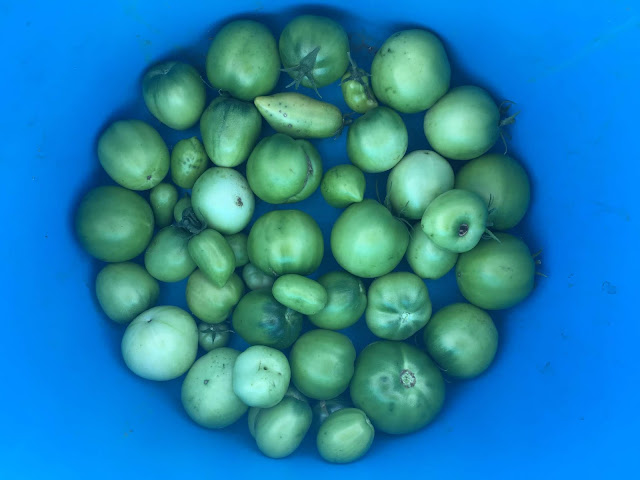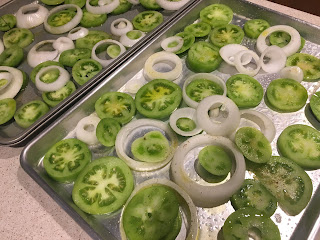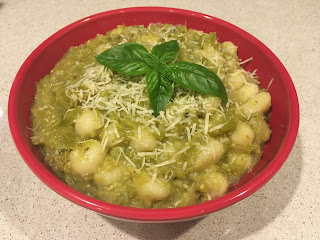
Recipe: Use those late-season green tomatoes in a casual fall meal
 |
| Got green tomatoes? Roast them to make a delicious sauce. (Photos: Kathy Morrison) |
At my community garden, I’m usually one of the last gardeners to pull out their tomato plants. One reason is I typically have three or four cherry-tomato plants still producing, notably the unstoppable Juliet variety. That one will carry on until frost if I let it.
But another reason is I grow a lot of tomato plants, and a few are so pretty and green again by October that I hold off turning them into compost. Not all of these set new tomatoes, but this fall the continuing warm weather prompted several to do so, including my Big Beef and First Prize plants. But I knew I was kidding myself about seeing many more red full-size tomatoes the rest of the year. So I picked most of them last weekend and hunted for a new way to use green tomatoes.
Now, of course, the cooler nights and the smoky skies are shutting down tomato production anyway, as Debbie detailed in this week’s Garden Checklist .
In the past I’ve canned a lovely green tomato chutney and a spicy green tomato jam, but I didn’t want to get out the canning kettle this time. Instead I hit on the idea of making a roasted green tomato sauce. Was there such a thing? An Internet search turned up a few variations, notably one on Genius Kitchen which I used as inspiration to create the Italian-style sauce here.
The resulting sauce wasn’t as piquant as I feared it might be -- the long roasting time and the additional of roasted white onions mellowed the flavor. Basil from my still-producing plants plus garlic and red pepper flakes added depth.
I tossed the sauce with potato gnocchi and served it alongside chicken Italian sausages, with an Amador County sangiovese to drink. Delicious, and a nice change from red sauce.

|
Roasted green tomato sauce
Makes enough for 6 side dish servings
Ingredients:
Extra virgin olive oil, for pan and for drizzling
3 pounds medium green (unripened) tomatoes, about 12
1 large white onion
Salt and freshly ground pepper
3 to 6 fresh garlic cloves (I used 6, but I love garlic)
24 basil leaves, plus more for garnish
⅛ teaspoon dried red pepper flakes
Prepared potato gnocchi, polenta, or pasta of your choice
Grated Parmesan cheese

|
Comments
0 comments have been posted.Sacramento Digs Gardening to your inbox.
Food in My Back Yard Series
April 29: What's (already) wrong with my tomato plants?
April 22: Should you stock up on fertilizer? (Yes!)
April 15: Grow culinary herbs in containers
April 8: When to plant summer vegetables
April 1: Don't be fooled by these garden myths
March 25: Fertilizer tips: How to 'feed' your vegetables for healthy growth
March 18: Time to give vegetable seedlings some more space
March 11: Ways to win the fight against weeds
March 4: Potatoes from the garden
Feb. 25: Plant a fruit tree now -- for later
Feb. 18: How to squeeze more food into less space
Feb. 11: When to plant? Consider staggering your transplants
Feb. 4: Starting in seed starting
Sites We Like
Garden Checklist for week of May 4
Enjoy this spring weather – and get gardening!
* Plant, plant, plant! It’s prime planting season in the Sacramento area. Time to set out those tomato transplants along with peppers and eggplants. Pinch off any flowers on new transplants to make them concentrate on establishing roots instead of setting premature fruit.
* Direct-seed melons, cucumbers, summer squash, corn, radishes, pumpkins and annual herbs such as basil.
* Harvest cabbage, lettuce, peas and green onions.
* In the flower garden, direct-seed sunflowers, cosmos, salvia, zinnias, marigolds, celosia and asters. (You also can transplant seedlings for many of the same flowers.)
* Plant dahlia tubers. Other perennials to set out include verbena, coreopsis, coneflower and astilbe.
* Transplant petunias, marigolds and perennial flowers such as astilbe, columbine, coneflowers, coreopsis, dahlias, rudbeckia and verbena.
* Keep an eye out for slugs, snails, earwigs and aphids that want to dine on tender new growth.
* Feed summer bloomers with a balanced fertilizer.
* For continued bloom, cut off spent flowers on roses as well as other flowering plants.
* Add mulch to the garden to maintain moisture. Mulch also cuts down on weeds. But don’t let it mound around the stems or trunks of trees or shrubs. Leave about a 6-inch to 1-foot circle to avoid crown rot or other problems.